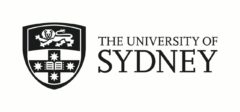Dear Historians,
Welcome to the 2017 academic year! We would like to invite you all to our welcome drinks for postgraduate students and history staff on Monday 13 March. We hope this event will provide everyone with the opportunity to meet our incoming students and to kick off the new year.
Warwick Anderson has kindly allowed us to host the drinks at REGS on the battlements again this year. Drinks and nibbles will be provided. If you are planning on coming along please let us know via email to help us confirm numbers for catering.
Time/date: Monday March 13 at 4.30pm
Location: REGS battlements (directions attached)
Looking forward to seeing you all then,
Emma Kluge, Hollie Pich and Marama Whyte
Postgraduate Representatives 2017
Department of History
[email protected]
University of Sydney Postgraduate History Conference Wrap-up
On the 23 and 24 November 2016 the Department of History successfully hosted the annual University of Sydney Postgraduate History conference. The theme for the conference this year was ‘Historical Identities’.
The keynote was delivered by Dr Sarah Walsh from the centre for Race and Ethnicity in the Global South (REGS) at the University of Sydney. Her paper ‘Latinizing Whiteness: Race, Nation, and Visual Culture in Latin America’, focused on constructions of whiteness in relation to national identity in nineteenth and twentieth-century South America, with particular focus given to Chile. Through Walsh’s exploration of how racial identity is both constructed and utilised her paper offered a stimulating beginning to the conference.
The conference was well attended with over fifty papers delivered over the two days. Presenters came from local universities, interstate and even as far as New Zealand. Sessions contemplated the concept of ‘identity’ and how it might be used to historically investigate in a variety of time periods and geographic locations, from the ancient world to the twentieth century, to Europe, the Americas and Asia-Pacific.
Special thanks to the team of volunteer postgraduate students, headed by our 2016 postgraduate representatives, Sarah Bendall and Georgia Lawrence-Doyle, who organised the conference, and to the department of history for generously funding the conference.
We look forward to hosting another successful conference next year.
To see the organising committee and past conference programmes, please visit our website: https://usydhistoryconference.wordpress.com
Miller Technology Prize Ceremony
In August this year, Year 11 students from Miller Technology and Granville Boys High School presented the results of their History Investigative Projects to their peers, mentors, and teachers. On Wednesday, 30 November, Miller Technology held a prize ceremony to acknowledge the best essays and presentations submitted by Miller students for their projects.
The school welcomed back former Miller student and USYD graduate, Annie Ha, to talk about her university experience after successfully completing a Bachelor of Education and Bachelor of Science and landing a full-time teaching role at a nearby school. Annie also gave advice on applying for scholarships and encouraged the students to pursue their interests at university. Mike McDonnell followed Annie’s speech with a talk about the plethora of options available at university, and the many places that studying the humanities especially can take lead.
Mike and History teacher Tony Podolsak awarded prizes for the most outstanding Year 11 Ancient History essays. In first place was Lan Pham, who the judges found, ‘made a clear and compelling case for the the value of comparative history’ in her essay on the sun gods of Ancient Egyptian and Aztec civilisations.
Melissa Clement and Tanya Nguyen came in equal second place, with well-written and researched essays on Constantine’s role in Christianity, and the importance of Taoism, Buddhism, and Confucianism in Chinese history, respectively.
The best presentations from August were also recognised during the prize ceremony: Gabriella Puruto won first prize for her extremely well-delivered presentation on Classical Greek architecture, with Marcelo Locardi-Rauth coming in a close second place. Marcelo’s presentation was on the topic of Pompeii.
To give an indication of the calibre of these presentations, Gabriella presented her work to the assembled students and teachers, as well as the principal, Ken Edge. As had been clear during her August presentation, Gabriella demonstrated that she knew her topic extremely well and displayed an enviable level of comfort with public speaking.
It was a fantastic note on which to end the year, and we wish the students all the best with their HSC studies in 2017.
Chifley College Prize Ceremony
Each year, Chifley College acknowledges its outstanding Human Society and Its Environment (HSIE) students in a prize ceremony. On Friday, 4 November, prizes were awarded to the best-performing Year 11 students in subjects such as Modern and Ancient History, Society and Culture, Aboriginal Studies, and Business Studies.
A select number of Modern and Ancient History students were also recognised for essays completed for their History Investigation Projects. These essays were judged by academics from the Department of History and the Department of Classics and Ancient History.
Jackson Clarke and Leilani Fakatava were joint winners of the Ancient History essay prize, and Kelsi Ryan placed third. Jackson, Leilani and Kelsi had tackled the topic of Roman Emperor Commodus, and the judges were ‘very impressed by the standard of all three papers.’ Each student offered a careful reading of ancient sources and engaged with the complexities of the narrative tradition about Commodus.
For Modern History, Leilani Fakatava and Shweeta Naidu were announced joint winners, with Jackson Clarke coming in third place. The judges found that Leilani’s work on indigeneity expressed ‘a range of sophisticated ideas about the multiple effects of dispossession – encompassing pride, pain, and resilience – and the complexities of racial identification.’ Shweeta’s essay on the Tiananmen Square massacre demonstrated ‘a great facility for historical storytelling, with a narrative that is clear, informative, and wide-ranging.’
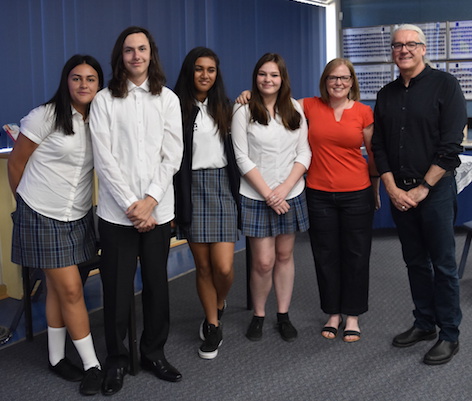
Prize winners Leilani, Jackson, Shweeta, and Kelsi with Dr Frances Clarke and Associate Professor Michael McDonnell
It was a wonderful occasion to celebrate the students’ achievements in the company of their parents, teachers, and peers – especially now that they have commenced their HSC studies.
Awards for the best HSC History Extension and Society and Culture major works were also announced on the day, with Juliana Campbell taking both titles. Juliana participated in the 2016 History Extension mentoring program.
We are excited to work with Chifley students Amber Leigh-Sanders, Jackson Clarke, Kelsi Ryan, Leilani Fakatava, and Shweeta Naidu as part of the 2017 History Extension mentoring program. Leilani is also participating in the University’s Year 12 Bunga Barrabugu Summer Program in the arts and social sciences stream, along with IT & Design student Justin Deville.
This year’s Extension mentors are USYD graduates Amelia Williams, Luke Cantrill, and Mirela Kadric, and they will work alongside Chifley history teacher Terri Katsikaros to guide the students’ research and writing skills over the next six months.
Cecil Hills – History Extension mentoring program
On Wednesday, December 7, the Department of History and the Department of Classics and Ancient History commenced a new partnership with Cecil Hills High School, as part of the History Extension mentoring program. Located in south-west Sydney, Cecil Hills is a large but vibrant school where over eighty percent of students have a language background other than English. In the week prior to our visit, the school had just celebrated its twentieth year.
USYD History students Stephanie Schenk, Sarah Charak, and Samantha Lawford were selected as mentors for the program, and they spent the first session with Year 12 students Alyssa Marsili, Kayla Oshana, and Christina Hanna working to refine their research topics and each develop a specific line of inquiry engaging with historiographical debates. Alyssa, Kayla, and Christina are tackling a range of topics from Native American to Russian and Assyrian history.
The students found this first session very useful. Alyssa wrote that “I was able to gain a different perspective on my chosen topic due to the the feedback I received, which helped me finally attempt to narrow down my argument and thesis.”
Christina thought that “the uni visit was a beneficial experience that raised many questions which I had not thought about concerning my extension project. I left the mentoring session with new ideas and new things to implement into my project. My mentor was extremely helpful and gave me many starting points and suggestions.”
And Kayla added, importantly, “It was an incredibly helpful and fun experience!”
The program consists of five school and university visits over a six-month period, where the mentors also provide guidance on applying to and studying at university. We are looking forward to hosting the students here at the University of Sydney in February, when they will meet up with the students and mentors from the History Extension program at Chifley College Senior Campus and get a chance to tour the campus before doing some research in the library.
Students and mentors work together on initial ideas while teacher Felicity Wicks looks on
We are very pleased to have created this new relationship with Cecil Hills High School, and look forward to getting to know the students better. We are especially keen to encourage students with second languages (and more) to study history at Sydney because those abilities are invaluable in our increasingly globalising world, and of course new international history initiatives.
We are also grateful to teachers Stephanie Haskett and Felicity Wicks for their enthusiasm for the program. Both are creative and inspiring teachers who are already teaching us new tricks for the classroom. Felicity promises to introduce us to the world of Virtual Reality and History on our next visit. While running the mentoring program, we also hope to visit with and host Stephanie’s Year 12 Ancient History students, too.
Finally, in a nice turn, one of the student mentors who volunteered to work with the Cecil Hills group, Steph Schenk (who is in her 3rd year of Uni) told us that she first decided she wanted to go to Sydney Uni when she came here five years ago with Trinity Catholic College, Auburn, and did a campus tour with student volunteers and heard mini-lectures from Helen Dunstan and Robert McCowan. It turned out that was one of the first school visits we organised to the Uni as part of this program, and it was the first time Steph had visited a University. We are very pleased that Steph is now a valuable volunteer on the program, and pursuing a teaching career.
Granville Boys High School Presentations and Awards
Earlier in the year, we reported on the Year 7 Granville Boys High School visit to the University and Museums. We’ve pasted a copy of that report below, and we’ve also provided a link to a short video of that trip created and provided by one of their teachers, Fiona Donnelly: https://youtu.be/vaYaBBJxSXg
Last week, we were invited to GBHS to view the final projects and award prizes and certificates to the best teams and students involved in them.
We were amazed at the work the boys did. They were split in to teams of three and four and tasked with a project of building virtual museum on the topic of “How Do the Dead Speak to Us?” The boys chose who would be their primary researcher, who would undertake the website design, and who would choose artifacts, texts, and pictures to use in their virtual museums.
The boys worked hard but also enjoyed the new challenge of working in a team and building something tangible that their parents and friends could also see. Some of their reflections can be found here on this video created and provided by Ms. Donnelly: https://youtu.be/-oEKbFl8Z5M
Using the website development tool Weebly, the boys created some terrific websites on different archaeological figures including Tutankhamun, Tollund Man, Narrabeen Man, Mungo Man, Otzi the Iceman and Ramesses II.
The work they did is also testimony to the innovative and creative thinking of the HSIE team at Granville, including teachers Fiona Donnelly, Stephanie Ghassibe, Tarek El-Homsi, and Chris Mandarakas.
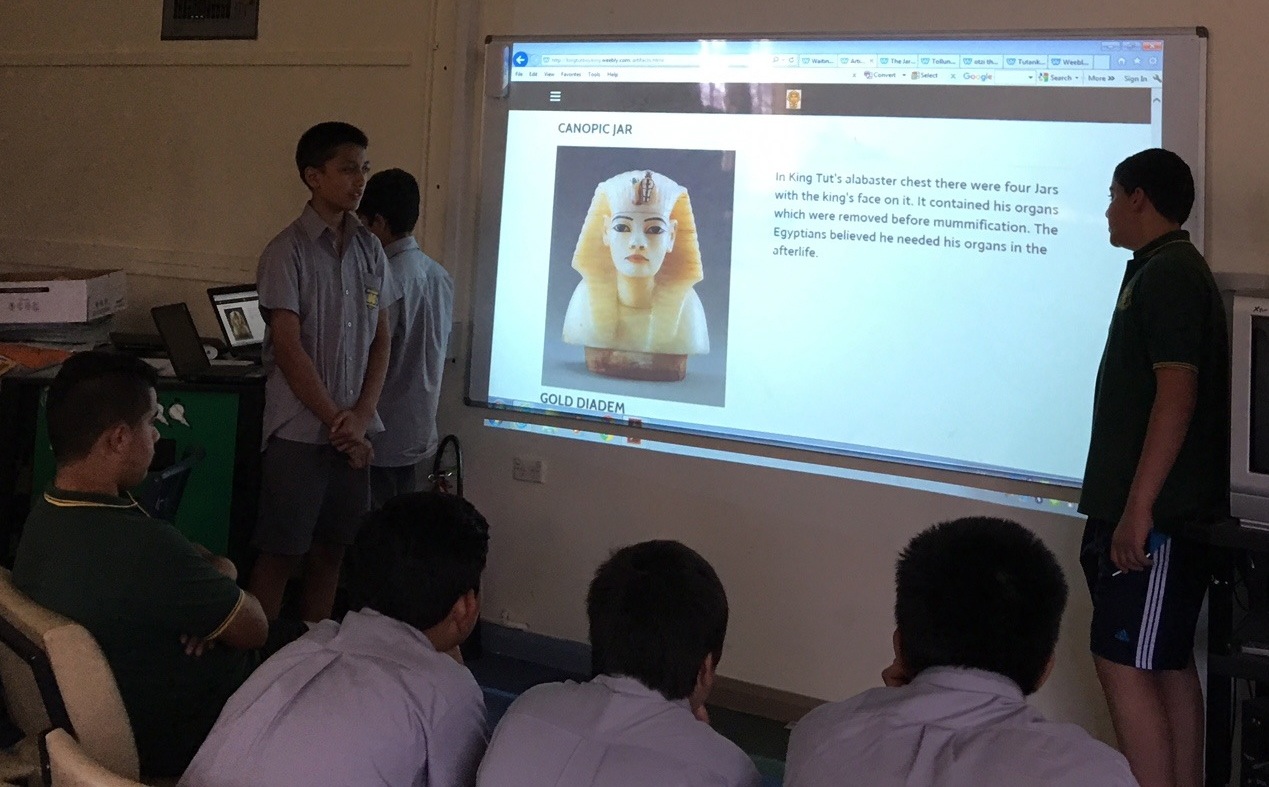
Though all the final presentations were excellent, the Department of History awarded the following certificates and prizes:
Certificate of Excellence and Prize
Hosam Al-Ubudi
Certificate of Excellence and Prize
Noah Kheir
Mohamed Saddieh
Rabih El Kheir
Certificate of Merit
Mohamed Agha
Mortatha Alhessany
Mohamed Dunia
Certificate of Merit
Ben Harfis
Ahmed Al Fararjeh
Zimraan Anjum
We look forward to working with the next group of Year 7 students early in the new year.
Original Report on Visit
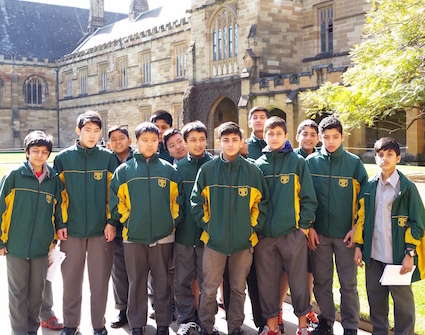
Year 7 Granville students at the University
Over the past four years, several groups of students from Granville Boys High School have visited the University of Sydney as part of the Social Inclusion program – usually Year 11 students completing individual research projects. On the 12th and 17th of August, the university hosted four classes of Year 7s in a pilot for a Project Based Learning program.
For this new project, Granville students will be investigating ancient artefacts and human remains, particularly looking at how remnants of the past are used to bring history to life in the present-day. Their case studies will include Ancient Egyptian mummies, Otzi the Iceman, and closer to home, Mungo Lady and Mungo Man. The students visited the Nicholson and Macleay museums to get a closer look and a better understanding of the importance of artefacts and remains, as well as the processes of preservation, storage, and presentation.
At the Nicholson Museum, the students handled artefacts such as canopic jars, ceramic sherds, mummy wrappings, grave-robber lamps, and Sumerian tablets. While handling these collections, they applied a series of questions to determine each object’s material, date, and place of origin. In the end it was the two swords – one Cypriot, the other Mycenaean – that drew the most attention from the students.
The staff at the Nicholson Museum were terrific guides and hosts for the boys. Craig Barker also took a group for an impromptu chat about the mummies, but quickly found out that at least one of the boys had been doing a little work on his own, and could describe the process of mummification down to the finest detail. His friends, along with us, were amazed.
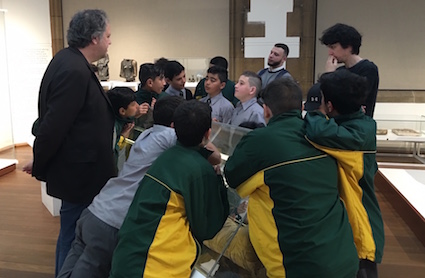
Dr Craig Barker with students in the Nicholson Museum
After learning about the material cultures of ancient civilisations at the Nicholson, the students explored Macleay Museum’s natural history collection. Upon their arrival, Jude Philp, Senior Curator at Macleay, tasked the students with locating the oldest and weirdest objects on display. Several of the students were also determined to find fake objects – but turns out the entire collection is real! Even at the end of what was quite a long day, the students were bursting with questions about the scientific instruments and animal life on display, how they were collected, and what it is like working in a museum.
We are looking forward to seeing their projects at school. And judging by their enthusiasm for learning about the history of the University and how we study history at the University and Museums, we are also looking forward to having them as students in a few years’ time.
HDR+ Student Grant Success
As the year winds down the Department is very pleased to note that Hollie Pich, Marama Whyte, and Sarah Dunstan from the Department of History were all successful in their applications for 2017 HDR+ Student Grants (https://sydney.edu.au/education-portfolio/ei/strategic-education-grants/2017/hdr-student-grants/)
Hollie and Marama were successful in their bid to organise and host a series of seminars around the theme: Working Women: A Forum for Women in Academia
Sarah was successful in her bid to organise and host a series of seminars around the theme of building key skills for higher degree research success.
Their proposals were terrific, and our Chair, Professor Chris Hilliard, has kindly agreed to match the funds given by the University to show the department’s support for such great initiatives.
Details of the seminars, which will run in 1st semester of next year, will follow in the new year.
This is terrific news and is testimony to the high quality work being done by our PG students, their innovative ideas, and their commitment to support the PG community.
Congratulations!
Mike McDonnell
“It’s finished, it’s submitted, now relax”
“It’s finished, it’s submitted, now relax” – A few short words from my proud grandmother upon the completion of my final project for the unit, ‘History beyond the Classroom’. It is hard to believe that after more than three months of hard work, my walking tour and the accompanying brochure, website and Facebook page are all finished – at least for now.
The response to the Alison Road Walking Tour has been unfathomable. I announced the official launch of the tour just over a day ago and I have received so much positive feedback that it is almost overwhelming. In just one day, the Facebook page for the walking tour received more than fifty likes and this number continues to grow daily. My status on my own account also received more than one hundred likes and thirty comments. From this, I have received several requests to conduct guided tours of Alison Road, which I have readily agreed to do. Next year, I will be returning to my old high school to take the senior modern history students on the tour myself. I cannot wait to share everything that I have learned throughout the project with those that share my passion.
Beyond this, the tour has already reached a far greater audience than I ever anticipated. The page has been shared several times, including most notably by the Wyong Family History Group, Wyong Photos and Chit Chat and the NSW & ACT Association of Family History Societies Inc. I am so honoured and proud to see my work promoted and endorsed by these organisations. It gives me real hope that Alison Road Walking Tour can be developed into something more than just a university project. I have many plans for the tour and I cannot wait to carry them out!
Finally, I have to be honest and admit that it is a bittersweet feeling to be finished. One the one hand, I am proud to see the final result of all the work I have done over the past few months, while on the other hand, I am reluctant to finish such an engaging and ground-breaking unit. ‘History beyond the Classroom’ is like no other unit I have studied at university. It has not only changed my approach to the study of history but also influenced the way in which I will teach the subject to my students as a future teacher!
Who’s reading their local paper?
The last time I read my local paper was… well, I can’t exactly recall. The Parramatta Sun arrives on my doorstep (or somewhere in the general vicinity – usually in a gutter or wedged under a car wheel) on a semi-regular basis, and yet it is only on the rare occasion where I feel like an easy Sudoku ‘challenge’ that I have a flip through its pages. Like most millennials, I get my news online, and in a globalising world, local news appears to be losing relevance. If you were to ask me who any of the contributors to my local paper were, or which section was my preferred read, I would not know what to tell you.
If you were to ask me the same about the Auburn Review, my answers may be a little different. After sifting through every edition of Auburn’s local paper over the past thirty years you’d certainly hope so. As part of my project, which looks into the history of the Auburn Youth Centre, I spent countless hours flicking through the yellowing pages of the Auburn Review in search for anything and everything I could find about the community organisation.
At first, my reading of these papers seemed to conjure more questions than answers.
How does a journalist manage to recycle the same story about footpath improvements over several years?
Is every front page article from 1988 going to be about syringes?
Why is Auburn Baseball Club pleading for ladies to enter their ‘lovely legs competition’? What is a lovely legs competition?
Did the Community Improvement Association realise their acronym would be CIA? Is that why they picked it?
And yet, the real question on my mind was: How did the Auburn Youth Centre feature in the local community – why was it so important for the local youth to have access to this organisation, and how did it benefit their lives?
Although my peripheral questions may forever remain an enigma, the answers I craved were there in the bound editions of the Auburn Review. Looking through the entire issue of the paper really gave an insight into the character of the community. I couldn’t ‘Ctrl+F’ ‘Youth Centre’ like in a digital edition (although my eyes may have developed a sharp radar for locating the words manually), but the lengthy process which resulted was entirely worth it.
The papers revealed so much about the needs of the Community. Certain themes were consistently brought up, and helped to establish context beyond the advertised offer of the centre. I was able to see for myself that Auburn Youth Centre was genuinely needed in the community. Prior to its establishment, there were few affordable activities available for teenagers in the area. Youth surveys and investigations showcased the issues which were at the forefront for Auburn youth: unemployment, substance abuse, boredom, and absence of a platform to voice their needs. The initiatives of the Auburn Youth Centre directly responded to these needs, and it became a valuable asset to the community. Coverage of the operations of the organisation by the local paper, in combination with an outlook over just how well AYC services corresponded to the needs of the community, show that the Auburn Youth Centre consistently provided an indispensable service to local youth.
There is so much to be learnt about the workings and character of a community just by reading the local publications – my research into AYC has shown me that. It has also encouraged me to become more interested in my own local community. The next time I find a soggy copy of the Parramatta Sun resting on my driveway, I will have a read through it to become an expert in my own local history – before it becomes history.
History of Ice Rinks and Ice Skating in Australia
The history of ice rinks and ice skating in Australia is not that long due to Australia’s climate and weather. The first official dates for the start of ice skating in Australia is 1904. In September 1904, the first artificial ice skating rink “the Glaciarium” opened in Adelaide, South Australia. There have been un-supported reports of a Sydney rink on Pitt Street in the late 1870s-early 1880s, which research has not been able to corroborate. The Glaciarium in Adelaide was only open for about a year and today is the home of the Adelaide Symphony Orchestra.
Newman Reid was said to be a pioneer of national ice sports and the founder of ice hockey in Australia. Reid was born in 1862 in Rochester, Kent. He was apart of the entrepreneurial syndicate that established the first ice rink in Australia, the Adelaide Glaciarium in 1904. Reid’s syndicates then went on to build the first ice rinks in Melbourne 1906 and Sydney 1907. “His world-class facilities for figure skating, speed skating and ice hockey were built with venture capital over a century ago and produced the first two generations of National ice champions, and many others who represented Australia at Olympic and World Championships”.
Mr. Dunbar Poole, a Scot, arrived in Adelaide around 1903 to find a group of like minded people interested in ice skating. This included future manager Newman Reid. They opened the rink in Adelaide in a building formerly used as cyclorama with the refrigeration being piped many metres from an ice works down the street.

The Sunday times newspaper article from July, 1907 introduces the first Sydney Glaciarium. The article states that ice skating is now not limited to those in “chilly districts”. A Sydney Morning Herald article from later that month also speaks of the Sydney Glacirarium opening. This article describes the rink below;
“Skating on the frozen lake to an Englishman is a pleasant and healthful exercise, but it is a pastime that is not easily obtainable in sunny Now South Wales, especially in the busy thoroughfares of a city like Sydney. Consequently in introducing ice skating to this city the management of the Glaclarium hopes to awaken pleasant memories in the minds of those who have previously skated in the fens of the motherland, and at the same time to raise a keen interest in this pastime in the minds of the people of Sydney who up to the present have known no other method than that of roller skating.”

Sydney Glaciarium
The timeline below shows some of the ice rinks operating in Australia prior to the 1970s. All Ice Rinks opened prior to the 1970s are closed, leaving Canterbury Olympic Ice Rink, the longest running ice rink in Australia. It opened it 1971, and will soon be celebrating its 50 year anniversary.
1904-1908 Adelaide Glaciarium
1906-1923 Melbourne Glaciarium
1907-1955 Sydney Glaciarium
1938-1951 Ice Palais – Sydney Showground
1939-1981 St Moritz Ice Rink – Melbourne
1949-1955 Perth Ice Palais
1959-1996/7 Prince Alfred Park ice skating rink – Sydney
1960-1963 Bondi Junction Ice Rink
1963-late 1970s Hindley Street Ice Skating Rink – Adelaide
1963-1982 Premier Ice Rink – Perth
1964-1969 Burwood Glaciarium
Continue reading “History of Ice Rinks and Ice Skating in Australia”
